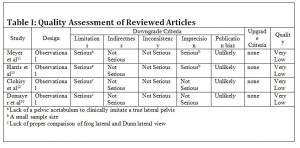Dunn Lateral View is the Most Predictable Plain Film Radiograph for Demonstrating a Cam Lesion in the Initial Diagnosis of Femoroacetabular Impingement
ABSTRACT
Background: Femoroacetabular impingement (FAI) has become increasingly recognized as a pathologic entity in individuals with hip pain leading to secondary osteoarthritis. Radiographic imaging is vitally important to the diagnosis of FAI. There is controversy over the most effective imaging techniques required to appreciate a cam lesion in lateral view plain film radiographs. Both Dunn and frog lateral views are used to appreciate cam lesions and research debates which view is most effective in measuring the degree of asphericity about the femoral head-neck junction. it has been proposed that a Dunn lateral view be taken. This has led clinical researchers to ask the following question: Is Dunn lateral the most predictable view in plain film radiographic demonstration of a cam lesion?
Methods: An exhaustive search of appropriate medical literature was conducted using MEDLINE-Ovid, CINAHL, and Web of Science, using the keywords: femoroacetabular impingement, Dunn lateral view, frog lateral view, radiographic, alpha angle, cam lesion, and cam impingement. Articles which met the clinical question and inclusion criteria of human participants and articles written in the English language were evaluated for quality using Grading of Recommendations, Assessment, Development and Evaluation (GRADE).
Results: Four studies met inclusion criteria. A retrospective study using 21 desiccated femurs compared six radiographic projections assessing cam lesion findings and concluded the Dunn lateral view to be most sensitive and specific in showing femoral head-neck asphericity. Another study reviewed radiographs of 61 hips treated for cam impingement and 24 asymptomatic control hips for accurate visualization of a cam lesion. They found the frog lateral view to be most accurate film compared to AP pelvis and cross-table lateral views. A retrospective study acquired CT arthrograms from 15 previously diagnosed patients with cam FAI. These were compared with a control group of 15 cadaveric femurs that were matched with height, weight, and BMI of the retrospect patients. Digitally reconstructed radiographs (DRR) were made in five views to correlate with the CT images of the FAI and control groups and alpha angles were measured showing the Dunn view as the highest correlation with the superior measurements of the CT arthrogram. The Dunn view was also considered superior to the frog lateral and AP views in cam lesion demonstration. Another retrospective study assessed the diagnostic sensitivity of Dunn view and cross-table lateral view in the evaluation of 60 cases of cam FAI by comparison with Radial MRI. The sensitivity for cam deformity was 96.4% in the Dunn view compared to 70% in the cross-table lateral view, showing the Dunn view was most appropriate for first line cam impingement diagnostics.
Conclusion: Studies suggest that the 45-degree Dunn lateral view is superior to other lateral views on plain film radiograph in the initial evaluation of cam lesions associated with FAI. Research is currently debated with regard to frog lateral views being equally as efficient. Further research using a large-scale retrospective comparison study should be performed in order to further validate the claim that the Dunn lateral view is superior to all lateral views in the initial demonstration of a cam lesion.
Keywords: Femoroacetabular impingement, cam impingement, cam lesion, alpha angle, Dunn lateral view, frog lateral view, cross-table lateral view.
(Click on image to enlarge.)
REVIEWED STUDIES:
Domayer SE, Ziebarth K, Chan J, Bixby S, Mamisch TC, Kim YJ. Femoroacetabular cam- type impingement: diagnostic sensitivity and specificity of radiographic views compared to radial MRI. Eur J Radiol. 2011; 80(3):805–10.
Meyer DC, Beck M, Ellis T, Ganz R, Leunig M. Comparison of six radiographic projections to assess femoral head/neck asphericity. Clin Orthop Relat Res. 2006; 445:181-185.
Clohisy JC, Nunley RM, Otto RJ, Schoenecker PL. The forg-leg lateral radiograph accurately visualized hip cam impingement. Clinical Orthopaedics & Related Research. 2007; 462:115-21.
Harris MD, Kapron AL, Peters CL, Anderson AE. Correlations between the alpha angle and femoral head asphericity: Implications and recommendations for the diagnosis of cam femoroacetabular impingement. European Journal of Radiology 2014; 83(5):788-96.
AUTHOR: Rory Hansen is currently completing his second year in the School of PA Studies at Pacific University, Oregon. He will graduate with an MS degree in August, 2016.

